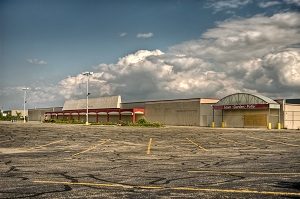By Amanda Duncan, President, PartnerOne Environmental
 There are millions of properties that are vacant or abandoned across the US, and the vacancy rate continues to increase as a result of Covid 19. Real estate is considered a vacant property when it is not currently occupied or in use. Vacant properties can be commercial, retail, industrial, or residential in nature. These properties bring down surrounding property values and hinder redevelopment. In addition, many environmental risks can be discovered, furthering impacting the structure itself or nearby areas.
There are millions of properties that are vacant or abandoned across the US, and the vacancy rate continues to increase as a result of Covid 19. Real estate is considered a vacant property when it is not currently occupied or in use. Vacant properties can be commercial, retail, industrial, or residential in nature. These properties bring down surrounding property values and hinder redevelopment. In addition, many environmental risks can be discovered, furthering impacting the structure itself or nearby areas.
Potential exposures for vacant properties may include:
- Older buildings may have existing asbestos insulation and tiles, as well as lead paint and lead piping.
- Leaking heating oil tanks, pipes, and appliances are prevalent, as well as any chemicals or lubricants stored on premises in garages or sheds.
- It is possible that unknown underground storage tanks exist onsite as well. Underground storage tanks that are not maintained regularly will most likely cause soil and groundwater contamination at the subject property itself, as well as surrounding real estate.
- Retail shopping centers or commercial office buildings that previously housed dry cleaners, printers, or restaurants have serious concerns pertaining to the improper storage and disposal of chemicals, inks, dyes and grease/oils.
- Poor maintenance, concrete cracks, dilapidated roofing, clogged sewer pipes and broken sprinkler systems can result in water intrusion and mold growth. Mold grows rapidly in warm and moist environments: bathrooms, basements, under carpeting, inside walls and HVAC ducts and can easily spread throughout a commercial, retail or residential structure, impacting others. In addition, weather-related events such as flash flooding can exacerbate indoor water and mold issues, and cause excessive surface water and silt runoff impacting neighboring properties or waterways such as ponds, streams or rivers. Should a waterway become impacted, not only is the quality of water at risk, but the plant and animal life as well (natural resources).
- Vacant buildings and land are very attractive locations to illegally dispose of potentially hazardous waste, drums, and containers. This practice is commonly referred to as “midnight dumping.” The drums and containers are almost never appropriate to properly contain the waste and the contents are easily released onto the property.
- Criminal activity at abandoned sites is a major concern. Illegal methamphetamine labs are established in abandoned properties regularly, with the remnants left behind after those involved move on.
Environmental insurance policies are routinely purchased for exposures associated with vacant properties. Contractors performing any rehabilitation/renovation work come into contact with potential contaminants during the course of debris removal, site preparation, demolition, grading, landscaping, and various other activities. A Contractors Pollution Liability (CPL) insurance policy will protect contractors if a pollution condition occurs as a result of their work, or work performed on their behalf. Property owners and managers purchase Site Pollution (PPL/EIL) policies covering both third party and first party claims, including Defense Costs, resulting from pollution conditions at, on, under, or emanating from scheduled locations (in this instance vacant properties). Environmental hazards associated with vacant sites such as Mold, storage tanks, midnight dumpling, in place asbestos and lead, soil/groundwater contamination, air and noise pollution, and improperly (or illegally) stored waste can be all addressed via a Site Pollution policy.
Vacant properties will remain a large part of our real estate landscape for the next several years and many issues can exist surrounding these sites. While the environmental concerns are many, the risks can be managed with the proper insurance policy in place, leading to future redevelopment and revitalization of the once vacant property.
